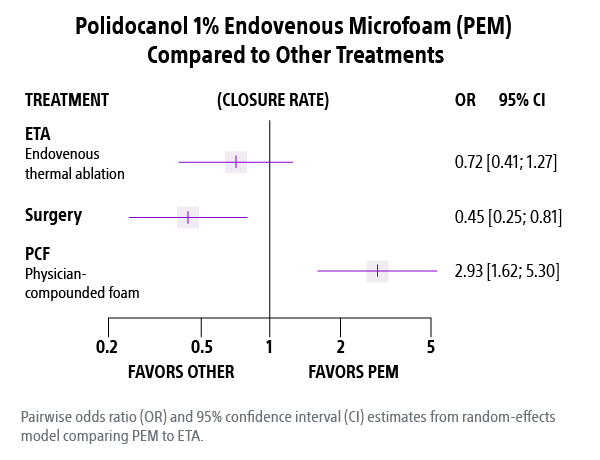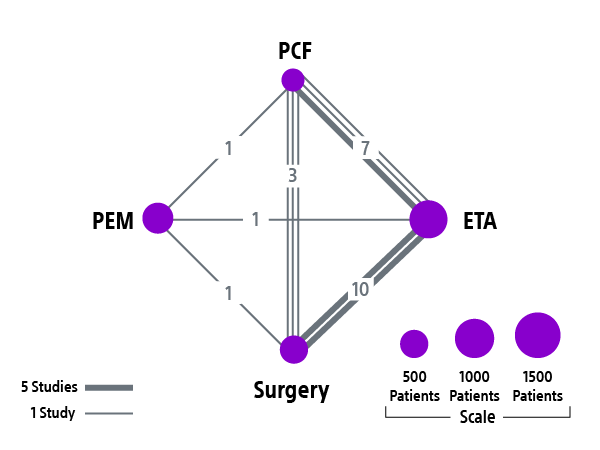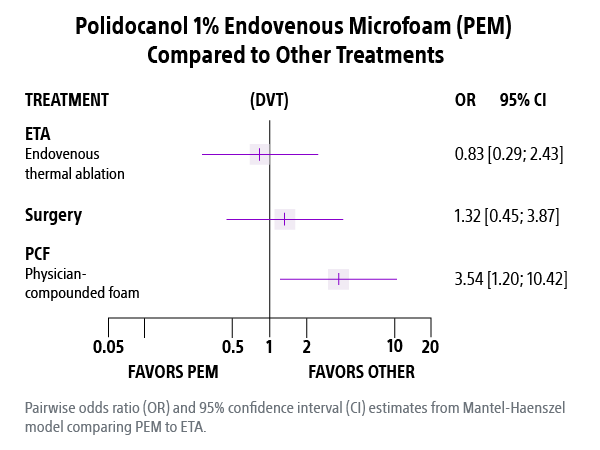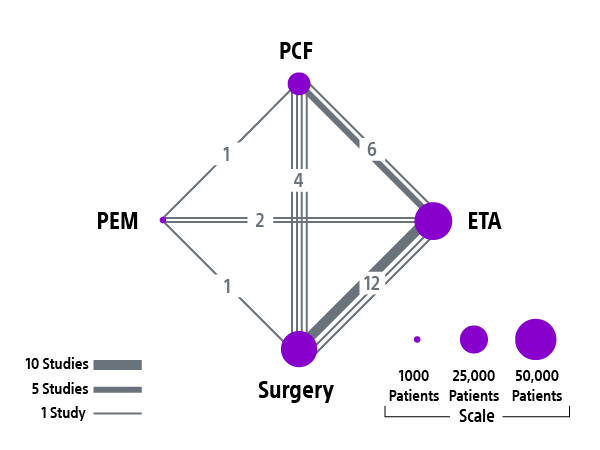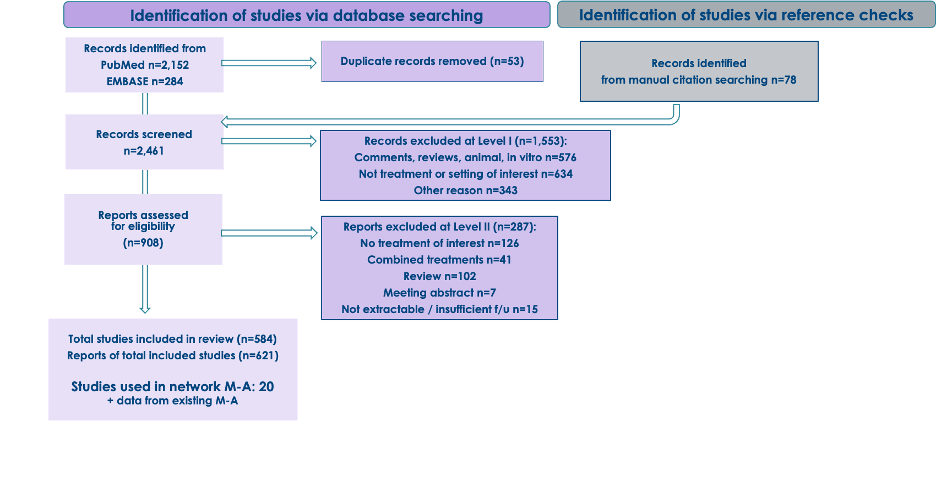Study Listing for Living Network Meta-Analysis of Polidocanol Endovenous Microfoam (Varithena™) for the Treatment of Chronic Venous Insufficiency:
Eligible studies as of search cut-off date January 31, 2025
"LINKED STUDY" indicates additional publication(s) reporting on the same or overlapping patient population as the primary study. Linked studies are grouped together for data extraction in order to represent outcomes comprehensively without double-counting patient results.
Studies in bold have been added to the living network meta-analysis since the original JVS-VL publication.
1. Biemans AA, Kockaert M, Akkersdijk GP, van den Bos RR, de Maeseneer MG, Cuypers P, et al. Comparing endovenous laser ablation, foam sclerotherapy, and conventional surgery for great saphenous varicose veins. J Vasc Surg 2013; 58: 727-34.e1.
LINKED STUDY: van der Velden SK, Biemans AA, De Maeseneer MG, Kockaert MA, Cuypers PW, Hollestein LM, et al. Five-year results of a randomized clinical trial of conventional surgery, endovenous laser ablation and ultrasound-guided foam sclerotherapy in patients with great saphenous varicose veins. Br J Surg 2015; 102: 1184-94.
2. Brittenden J, Cotton SC, Elders A, Ramsay CR, Norrie J, Burr J, et al. A randomized trial comparing treatments for varicose veins. N Engl J Med 2014; 371: 1218-27.
LINKED STUDY: Brittenden J, Cooper D, Dimitrova M, Scotland G, Cotton SC, Elders A, et al. Five-year outcomes of a randomized trial of treatments for varicose veins. N Engl J Med 2019; 381: 912-22.
LINKED STUDY: Brittenden J, Cotton SC, Elders A, Tassie E, Scotland G, Ramsay CR, et al. Clinical effectiveness and cost-effectiveness of foam sclerotherapy, endovenous laser ablation and surgery for varicose veins: results from the Comparison of LAser, Surgery and foam Sclerotherapy (CLASS) randomised controlled trial. Health Technol Assess 2015; 19: 1-342.
LINKED STUDY: Cotton SC, MacLennan G, Brittenden J, Prior M, Francis J. Behavioural recovery after treatment for varicose veins. Br J Surg 2016; 103: 374-81.
3. Deak ST. Treatment of superficial venous insufficiency in a large patient cohort with retrograde administration of ultrasound-guided polidocanol endovenous microfoam versus endovenous laser ablation. J Vasc Surg Venous Lymphat Disord 2022; 10: 999-1006.e2.
4. Erdinc I. Efficiency of endovenous laser and glue ablation methods in comparison with conventional surgery for the treatment of venous ulcers. Phlebology 2022; 37: 670-7.
5. Gonzalez-Zeh R, Armisen R, Barahona S. Endovenous laser and echo-guided foam ablation in great saphenous vein reflux: one-year follow-up results. J Vasc Surg 2008; 48: 940-6.
6. Hamel-Desnos C, Nyamekye I, Chauzat B, Gracia S, Josnin M, Abbadie F. FOVELASS: a randomised trial of endovenous laser ablation versus polidocanol foam for small saphenous vein incompetence. Eur J Vasc Endovasc Surg 2023; 65: 41523.
7. Kanber EM, Cetin HK. Comparison of radiofrequency ablation and saphenous vein stripping for the treatment of recurrent lower extremity venous insufficiency. Vasc Endovascular Surg 2023; 57: 726-31.
8. Kuserli Y, Kavala AA, Turkyilmaz S. Comparison of high saphenous ligation and stripping, radiofrequency ablation, and subfascial endoscopic perforator surgery for the treatment of active venous ulcers: Retrospective cohort with five-year follow-up. Vascular 2022; 30: 375-83.
9. Li Q, Zhang C, Yuan Z, Shao ZQ, Wang J. Endovenous laser treatment vs conventional surgery for great saphenous vein varicosities: A propensity score matching analysis. World J Clin Cases 2023; 11: 8291-9.
10. Mallick R, Raju A, Campbell C, Carlton R, Wright D, Boswell K, et al. Treatment patterns and outcomes in patients with varicose veins. Am Health Drug Benefits 2016; 9: 455-65.
LINKED STUDY: O'Donnell TF, Eaddy M, Raju A, Boswell K, Wright D. Assessment of thrombotic adverse events and treatment patterns associated with varicose vein treatment. J Vasc Surg Venous Lymphat Disord 2015; 3: 27-34.
11. Mishra MK, Soni RK, Mohil RS, Sinha A. Comparative study of outcome of duplex ultrasound-guided, catheter-directed foam sclerotherapy and radio-frequency ablation in the management of great saphenous varicose veins. Indian J Surg 2016; 78: 375-81.
12. Mousa A, El Azzazi M, Elkalla MA. Different management options for primary varicose veins in females: A prospective study. Surg Open Sci 2019; 1: 25-33.
13. Pappas PJ, Lakhanpal S, Nguyen KQ, Fernandez E, Sufian S. Extended Center for Vein Restoration study assessing comparative outcomes for the treatment of chronic venous insufficiency in Medicare- and non-Medicare-eligible patients. J Vasc Surg Venous Lymphat Disord 2021; 9: 1426-36 e2.
LINKED STUDY: Deol ZK, Lakhanpal S, Franzon G, Pappas PJ. Effect of obesity on chronic venous insufficiency treatment outcomes. J Vasc Surg Venous Lymphat Disord 2020; 8: 617-28.e1.
LINKED STUDY: Deol ZK, Lakhanpal S, Pappas PJ. Severity of disease and treatment outcomes of anterior accessory great saphenous veins compared with the great saphenous vein. J Vasc Surg Venous Lymphat Disord 2022; 10: 65460.
14. Png CYM, Schneider D, Nuzzolo K, Scovell S, Stoughton J. Popliteal vein reflux is associated with increased rates of thrombotic complications after small saphenous vein closure procedures. J Vasc Surg Venous Lymphat Disord 2022; 10: 1267-71.
15. Rajendran S, Nair HR, Irshad KM, Unais TM, Thaikattil NJ. Ultrasound-assisted varicose vein surgery and endovenous laser ablation using 1470-nm laser for treatment of great saphenous vein incompetence has similar outcomes at 1 year in a single-center prospective randomized study. J Vasc Surg Venous Lymphat Disord 2022; 10: 370-5.
16. Skoog J, Zachrisson H, Nelzén POE. Quantifiable remaining reflux 1 year after treatment of superficial venous incompetence is associated with impaired clinical outcome. J Vasc Surg Venous Lymphat Disord 2023; 11: 1130-8.
LINKED STUDY: Nelzen O, Skoog J, Bernfort L, Zachrisson H. Short term cost effectiveness of radiofrequency ablation and high ligation and stripping for great saphenous vein incompetence. Eur J Vasc Endovasc Surg 2024; 67: 811-7.
LINKED STUDY: Nelzén POE, Skoog J, Öster M, Zachrisson H. Impact on venous haemodynamics after treatment of great saphenous vein incompetence using plethysmography and duplex ultrasound. Phlebology 2020; 35: 495-504.
17. Sutton PA, El-Dhuwaib Y, Dyer J, Guy AJ. The incidence of post operative venous thromboembolism in patients undergoing varicose vein surgery recorded in Hospital Episode Statistics. Ann R Coll Surg Engl 2012; 94: 481-3.
18. Talutis SD, Chin AL, Lawrence PF, Woo K, Jimenez JC. Comparison of outcomes following polidocanol microfoam and radiofrequency ablation of incompetent thigh great and accessory saphenous veins. J Vasc Surg Venous Lymphat Disord 2023; 11: 916-20.
LINKED STUDY: Chin AL, Talutis SD, Lawrence PF, Woo K, Rigberg DA, Rollo JC, et al. Factors associated with ablation-related thrombus extension following microfoam versus radiofrequency saphenous vein closure. J Vasc Surg Venous Lymphat Disord 2024; 12: 101815.
LINKED STUDY: Chin AL, Talutis SD, Lawrence PF, Jimenez JC. Early results following comparison of radiofrequency and microfoam ablation of large diameter truncal veins demonstrate high closure rates and symptomatic relief. J Vasc Surg Venous Lymphat Disord 2023; 11: 716-22.
LINKED STUDY: Talutis SD, Chin AL, Lawrence PF, Woo K, Jimenez JC. Comparison of outcomes following polidocanol microfoam and radiofrequency ablation of incompetent thigh great and accessory saphenous veins. J Vasc Surg Venous Lymphat Disord 2023; 11: 916-20.
LINKED STUDY: Jimenez JC, Lawrence PF, Woo K, Chun TT, Farley SM, Rigberg DA, et al. Adjunctive techniques to minimize thrombotic complications following microfoam sclerotherapy of saphenous trunks and tributaries. J Vasc Surg Venous Lymphat Disord 2021; 9: 904-9.
19. Tiwary SK, Alam S, Sureka P, Kumar P, Khanna AK. Study of quality of life in patients with varicose vein after radiofrequency ablation and ultrasound guided foam sclerotherapy. Acta Phlebologica 2020; 21: 42-7.
20. Wright D, Gobin J, Bradbury A, Coleridge-Smith P, Spoelstra H, Berridge D, et al. Varisolve® polidocanol microfoam compared with surgery or sclerotherapy in the management of varicose veins in the presence of trunk vein incompetence: European randomized controlled trial. Phlebology 2006; 21: 180-90.
